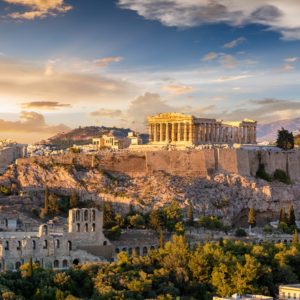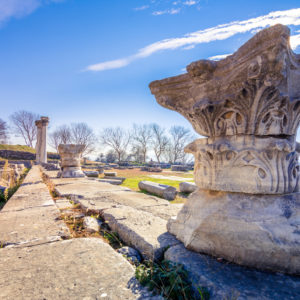The Temple of Olympian Zeus - Athens
The area where the river Ilissos once flowed through the heart of modern Athens has always carried a sacred significance. Along the left bank was the aforementioned Ardittos Hill, atop which the cult of the goddess Tyche was practiced, while on the right bank lay the sanctuary of Deucalion, the son of the Titan Prometheus, who, along with his wife Pyrrha, survived the global flood.
Legend has it that the spot where the Olympieion, or the Temple of Olympian Zeus, stands today was a fissure that, according to myth, swallowed all the waters of the flood. On specific days celebrating the cult of Deucalion, locals gathered in the area, sprinkling flour and pouring honey into the crevice as an offering to Deucalion, revered as both the progenitor of all Greeks and the memory of the generation that perished during the worldwide flood.
The idea to build the temple is believed to have originated during the rule of the tyrant Peisistratos, around 527 BCE. here is debate among scholars about when construction began, whether during the lifetime of Peisistratos himself or during the rule of his sons Hippias and Hipparchus. However, shortly after construction commenced, Athens experienced turmoil. Two prominent citizens, Harmodius and Aristogeiton, organized a conspiracy, assassinated Hipparchus, and forced Hippia to flee. Due to the ensuing political crisis, the building became the city’s most famous construction project, known for its prolonged duration.
During the peak of political influence in the city of the statesman and military leader Themistocles, parts of the temple were practically integrated into the Long Walls—a system of fortifications connecting the center of Athens to the main port of Piraeus. The remnants of these defensive structures, explored by archaeologists, can be seen near the ruins of the Temple of Olympian Zeus to this day.
From 175 to 164 BCE, King Antiochus IV Epiphanes of Syria, belonging to the Seleucid dynasty, sought to gain the support of the entire Hellenistic world and allocated substantial funds for construction projects in various cities, including Athens. He assigned the task of continuing the construction to his court architect, the Roman Decimus Cossutius. Cossutius significantly altered the original design, replacing the austere Doric order with a more elaborate Corinthian one and using expensive Pentelic marble for the capitals. However, the death of the king disrupted all plans, and construction was once again put on hold. Later, in 86 BCE, Roman general Cornelius Sulla took one of the columns as a trophy to Rome for the embellishment of his palace on the Palatine Hill.
The dimensions of even the partially completed structure were such that the historian Titus Livius, who visited Athens in the 1st century CE, could not help but remark that “this temple is the only one in the world built in accordance with the greatness of a deity.”
Ultimately, Emperor Hadrian resumed the construction of the temple in the 2nd century CE. Hadrian was a great admirer of Greek culture, and under his rule, Athens experienced its last cultural and educational peak in antiquity. The consecration of the temple, which was never fully completed, took place in 132 CE, coinciding with the emperor’s second visit to the city. The dimensions of the temple are still impressive. It is situated on a platform measuring 250 meters in length and 130 meters in width. The double colonnade of 108 columns rose to a height of 17.25 meters, each with a diameter of 1.70 meters at the base and 20 flutes per circumference. Inside the temple stood a statue of Zeus made of gold and ivory, a reduced copy of Phidias’ masterpiece in Olympia—one of the Seven Wonders of the Ancient World. The sanctuary also housed statues of Hadrian and his favorite Antinous.
The Temple of Olympian Zeus was destroyed by earthquakes during the early Middle Ages. However, there are accounts that the summits of the columns of the Olympieion were favored by stylites—pillar saints, monks who chose the ascetic practice of prolonged stays atop tall towers or even on the capitals of columns of ancient temples, enduring the scorching sun or pouring rain. Sources also mention a monk named Sabbas, who fervently adhered to this ascetic practice. In 1759, the new Ottoman governor of Athens dismantled one of the columns to obtain construction materials for the city’s fifth mosque. Since, by law, the temple was considered the property of the sultan, the Ottoman authorities intervened seriously the following year.
In 1852, lightning struck one of the columns, causing it to collapse. Currently, 15 columns are in a vertical position—12 forming one of the corners of the temple, two standing separately, and one resting on the ground.





